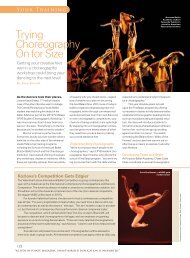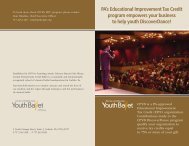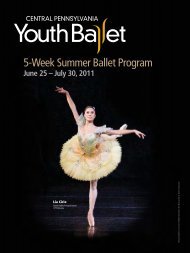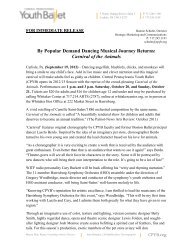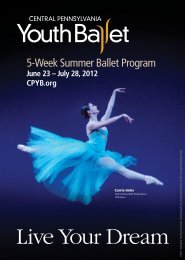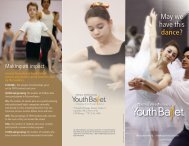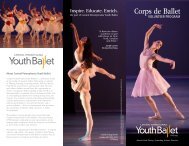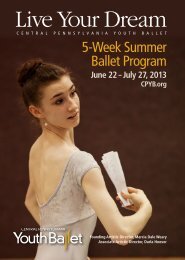AcADeMic HAnDbook - Central Pennsylvania Youth Ballet
AcADeMic HAnDbook - Central Pennsylvania Youth Ballet
AcADeMic HAnDbook - Central Pennsylvania Youth Ballet
- No tags were found...
You also want an ePaper? Increase the reach of your titles
YUMPU automatically turns print PDFs into web optimized ePapers that Google loves.
preschool division<strong>Central</strong> <strong>Pennsylvania</strong> <strong>Youth</strong> <strong>Ballet</strong>’s Preschool Divisionintroduces students to the world of dance throughmusic and movement. Students learn coordination,ballet vocabulary and classroom etiquette, in additionto developing life-long skills of focus and discipline.Mommy & Me (Ages 2 to 4)Parents/caregivers participate with childAn introduction to the art of dance in a nurturingenvironment ideal for children ages two to four yearsof age who are toilet trained. Imaginative exercisespresent an outlet for an active mind and satisfy achild’s natural instinct for movement. Classical, folkand traditional music are used to inspire songand movement.Creative Movement I (Age 3)Creative Movement II (Ages 4 to 5)A special class designed for children who are ready toseparate from their parent and dance independently.Children are introduced to the world of dance through acombination of classical, folk and traditional music. Exercisespromote early childhood development focusing on bodyawareness, gross motor skills, and individual expression.intro to dance (Ages 3 to 6)An introduction to the world of dance, this classcombines Pre-<strong>Ballet</strong> and Tap into an energy-filled hourof instruction. Students will be exposed to classical, folkand traditional musical styles while learning exercises thatdevelop balance, flexibility, rhythm and coordination.Tap (Ages 3 to 6)Tap class helps improve the student’s posture anddevelop rhythm and coordination. As tudents learnto put dance steps together in a variety of ways, theyimprove cognitive thinking skills. Precise musicalityand classroom etiquette are emphasized.Academic Divisionsprimary division(LEVELS 1 & 2)The Primary Division features the beginning levels forlearning ballet technique. This division consists of levels1A, 1B, 2A and 2B. As standard procedure, students of allages begin in Level 1A, learning the basic ballet positions,the progression of a standard ballet barre and the Frenchvocabulary that defines all of the steps in ballet. Thesestudents also move into beginning centre work, away fromthe support of the ballet barre.Students progress through these levels as through gradesin any school; however, all students move at differentrates. Some spend more than two years in one levelwhile the mind and the body learn to work together;some may progress much faster. When the student haslearned the ballet technique appropriate for each leveland when the student’s body has become strong enoughto accomplish those movements, then, at the discretion ofthe Artistic Director, the student is moved to the next level.Advancement is based on ability, not age. In this way, thestudent begins to assimilate the layers of knowledge thatform the foundation of ballet. Indeed, the primary levelsare the most important levels in ballet as they solidlyprepare the student for the rigors of performance.It is recommended that students, at a minimum, invest thefollowing amount of time into their ballet studies per week:Level 1A - 2 hoursLevel 1B - 4 hoursLevel 2A - 8 hoursLevel 2B - 10 hoursIn order to advance in comparison to other students, oneusually must take more than the above recommendednumber of hours; attending class five or six days per weekis not uncommon among 1A students.Pre-<strong>Ballet</strong> (Kindergarten, Ages 5 to 6)A prelude to formal ballet instruction, students will developa foundation for ballet technique in a non-competitivelearning environment fostering a love for dance and music.Exercises promote correct posture, technique and flexibility,while expanding gross motor skills and developing balanceand strength. Students begin learning French vocabulary,movement expression, and proper ballet etiquette.Photo: Amy Spangler.2013-2014 Academic Handbook & Student Policies | Updated 9.30.1311home



